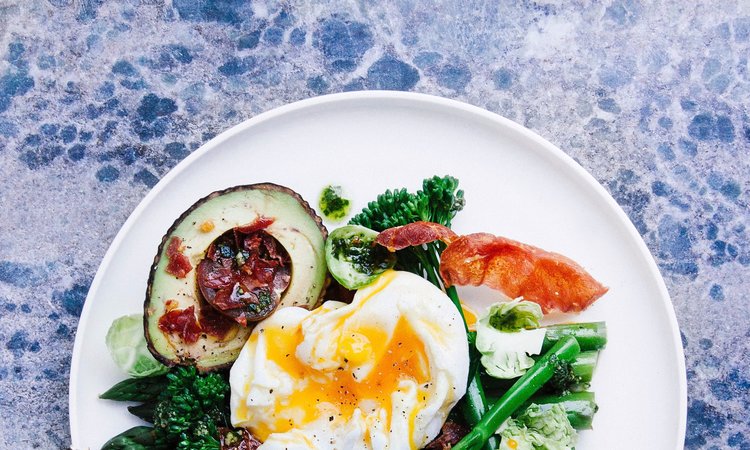What to Know About Paleo
- April 15, 2019
- No Responses

Food confusion is a real thing these days. There are so many different eating styles, it can be hard to keep them straight! Throw in the millions of bloggers, nutritionists, personal trainers, and doctors opinions, and no one knows what to eat anymore. Vegetarian, vegan, pescatarian, gluten-free, dairy-free, carnivore and keto. I want to get clear about the way I approach food, nutrition and most importantly how I define Paleo. Keep reading for “What to Know About Paleo.”
Simply put, the Paleolithic style is an ancestral approach to eating, going back to the foods that our bodies were intended to consume before the days of the agricultural revolution. It’s about eating whole, unprocessed, nutrient-dense foods that our bodies were designed to digest.
The agricultural revolution introduced wheat, sugar, vegetable oils and other “frankenfoods” into our food system, and since then, the rates of disease, especially autoimmune diseases, in this country have skyrocketed.
What is paleo?
- Lean meats
- Grass-fed beef
- Seafood
- Eggs
- Fruits & vegetables
- Nuts & seeds
- Heathful oils (olive, avocado, coconut, flaxseed)
What is not paleo?
- Gluten
- Dairy
- Grains
- Legumes (includes peanuts)
- Soy
- Processed foods
- Refined sugar
- Refined oils
At first glance, the public opinion of going paleo represents what some refer to as, “The Caveman Diet.” They assume the ‘diet’ consists of eating a lot of meat. Which then begs the question, “Isn’t having that much animal fat bad for you?”
Well, if all the meat you eat consists of bacon, then yes! But eating paleo doesn’t mean just swapping grains for meat. It means eating a large variety of vegetables and fruits. It means choosing proper amounts of meat that are lean and consciously sourced. To eat as close to how a Paleolithic human did, protein sources should ideally be grazing on grass, cage free and organic. When it comes to fat consumption, eating quality, healthy fats are important no matter the diet choices you make. Eating “low-fat” is an outdated dogma that needs to be erased from people’s minds.
Many people following a paleo lifestyle leave some wiggle room and liken themselves “paleo-ish” which I think is a great option. For instance, I occasionally consume peanuts and legumes. Some might cook with grass-fed butter or enjoy quinoa every now and then. You get the idea. I urge people to find the wiggle room that works for them and here’s why… any “diet” that feels too restrictive will be hard to maintain and make you feel guilty about “slip-ups.” Finding food peace is essential to longevity.
Who should eat the paleo way?
I would argue that eating a gluten-free diet full of whole, unprocessed foods would benefit everyone. That’s why I am co-authoring a new book titled, Primal Eating… coming soon! Inside it we get down to the nitty-gritty about ancestral health, eating to get lean and the frame work for lasting success. I know that eating in the paleo/primal way is the way to reversing disease and the aging process.
Getting more specific, there are certain groups of people who should seriously consider it. For instance, if you have any type of autoimmune condition: rheumatoid arthritis, lupus, MS, celiac, Hashimoto’s thyroiditis. A paleo diet is widely recommended. Additionally, a leaky gut is usually present in autoimmune conditions. By removing foods that contribute to leaky gut and cause inflammation like gluten, dairy, and processed sugars, you can begin to heal your body.
Paleo is a nutrient-dense diet free from foods that cause leaky gut and inflammation!
Gray Areas:
If you strictly categorize each food into “paleo” or “not paleo” it can get pretty exhausting and take much of the joy out of eating. The tenets of the paleo diet listed above are standard, but there are several foods that you’ll find are debatable. Here are just a few examples:
- Coffee: paleo friendly if you drink it without the cream and sugar, coffee can be an occasional part of a paleo lifestyle for those who can tolerate it. If it interrupts your sleep, irritates your gut or if you feel you’re becoming too dependent on it, try giving it up. If you have a hard time kicking the caffeine habit, green tea has lower levels of caffeine and loads of antioxidants.
- Chocolate: paleo friendly in moderation if the cocoa percentage is high (at least 70%). Dark chocolate has health benefits, like high levels of antioxidants, but you need to watch the sugar content.
- Potatoes: most paleo eaters avoid white potatoes because of the high carbohydrate content and high glycemic index. While eating a paleo diet is naturally a low-carb lifestyle, eating a range of healthy carbs is ok for most people. In general, a safer starch would be sweet potatoes, a paleo favorite.
It is not difficult to “go paleo,” but it does take work. Meal planning and thoughtful grocery shopping is a must. Because this diet revolution has been around for a while now, you’ll have no trouble finding paleo cookbooks, recipes, blogs and other resources.
My favorites:
Danielle Walker of Against All Grain
Paleomg (Juli Bauer)
Practical Paleo (book)
Because I am such a big supporter of this way of eating, I am attending the PaleoFX conference in Austin, TX the last weekend of April. If you’re in the area, I highly recommend checking it out or saying Hi!
Stay tuned for my new book coming soon titled, Primal Eating. I am co-authoring it with The Primal Man, and I can’t wait to share it with you!
Let me know if you’re brand new to paleo or have been “paleo” for a while like I have, in the comments below.



